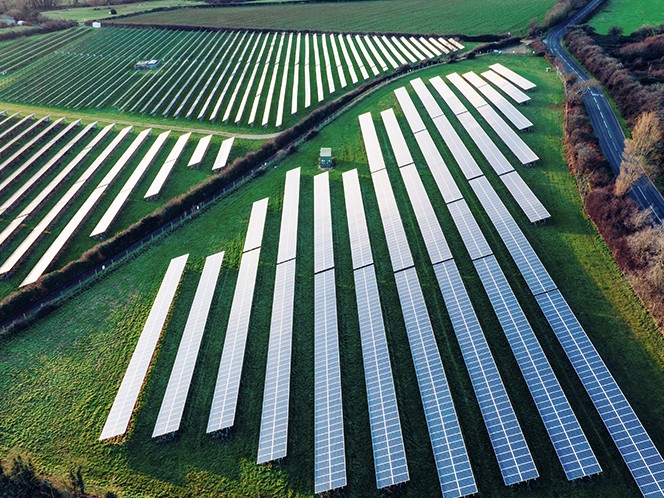Preparing for the solar boom: Four strategies for industrial organizations
Posted: April 30, 2025
Solar power is booming. This promising form of green energy production is expanding exponentially—with installations consistently outpacing predictions—and it is poised for even greater expansion and development in the coming years. The Economist estimates that by 2040, solar cells will not only be the dominant source of electricity but also of all energy.[1]
The rising heliocentrism of the energy industry presents both a massive opportunity and a looming challenge for businesses across industries. The chain of production that could benefit from this developing sector runs from the mining and minerals industries through, of course, power generation—which stands to see enormous gains. But, with supply chain bottlenecks, workforce shortages, and the need for new digital capabilities, companies that aren’t already actively preparing risk falling behind—and losing out on the benefits of the boom. Here are a few strategies for organizations to implement to set themselves up to successfully go solar.
Build a resilient supply chain to avoid disruptions
As demand for solar energy surges, so does the risk of shortages of critical materials for energy production, like lithium, copper, and polysilicon. AVEVA forecasts an increasingly tight market for materials critical to renewables.[2] Companies reliant on critical raw materials—whether for solar panels, battery storage, or industrial applications—or processed materials at earlier stages—such as polysilicon, ingots, wafers, cells and modules for solar panels— must begin to prepare to confront shortages and rethink their sourcing strategies to avoid bottlenecks.
Seventy-eight percent of industry leaders believe that there will be a largescale adoption of advanced analytics in the supply chain in the next five years.[3]
Organizations should not only act preemptively to confront the looming crunch of critical materials, but also integrate technology into their supply chain monitoring that can respond to the shortages before they happen. It is no surprise that 78% of industry leaders believe that there will be a largescale adoption of advanced analytics in the supply chain in the next five years.[4] With predictive analytics, organizations will be able to anticipate material shortages and shape their business strategies accordingly.
Another tool of particular promise in creating a unified value chain is the developing technology of blockchain. As opposed to traditional forms of data-sharing, blockchain enables secure, instantaneous exchange of information among as many partners as one needs—and offers a single source of truth. Blockchain is able to avoid siloed information by instantaneously logging every step of the supply chain. With every interaction clearly logged and time-stamped, businesses will be able to have a clear overview of the entire supply chain of their processes, enabling them to make the best choices every step of the way.
The final tactic that organizations should consider using when securing their supply chain against future shocks is diversifying their suppliers. In the current moment, the entire world increasingly relies on China for every step of the solar PV supply chain. The IEA notes that organizations rely on China for over 80% of the manufacturing of solar technology.[5] This means that energy producers are heavily reliant on a single country, the supply from which can be too easily affected by shifting geopolitics or health crises, as the was the case in the pandemic.

By working with new technologies and diversifying sources, organizations can model and plan to avoid the typical logjams that affect the scaling of production while also avoiding overreliance on a single supplier. Instead, with their team members having access to the data they need from advanced analytics or technologies like blockchain, organizations can benefit from the increased demand that businesses across the solar energy industry will see without having to deal with the usual logistical problems involved in scaling sourcing and production.
Bridge the skills gap with VR and workforce training
The supply chain crunch is not the only problem that organizations have to confront if they want to maximize their benefits from solar energy’s unprecedented boom. At this moment, businesses across industries are reckoning with, as the Harvard Business Review reports, an accelerating drain of expertise.[6] With evolving technologies “disrupting” standard operating procedure, not only do teams have to adapt to new routines and gain new expertise, they also have to adapt to losing their most experienced members. These changes are driving the people with the longest tenures into retirement. Many of these longstanding employees are deciding that, with paradigms shifting toward an AI-centric future, now is the right time to retire rather than have to go through the process of retraining to acquire the new skills necessary to thrive in this changing environment. As a result, organizations do not have the same level of expertise as in the past—a daunting reality when confronting a novel, but exciting, future.
Organizations are far from powerless when facing the drain on expertise. Across industries, businesses are turning to the possibilities offered by training in virtual reality environments. With such software, organizations can simulate collaboration between operators, maintenance, and field personnel from across the enterprise in a realistic environment—efficiently and cost-effectively.
With immersive environments, enterprises can ready their workforce and their organizations for the future. On-site and remote employees can train for present and future scenarios in concert with each other, getting ready for the challenges that the future will bring to the solar energy sector.
Enable seamless collaboration across teams and partners
As companies scale solar adoption, internal and external collaboration will be crucial. Real-time data sharing and transparent communication will separate successful enterprises from those struggling with inefficiencies. By fostering collaboration and increasing data transparency through the adoption of cloud platforms and solutions, businesses can expect to see immediate dividends. But more than that, they will also be laying the foundation for the future.

Talison Lithium, a lithium mining company, is one enterprise that has sought to facilitate frictionless collaboration by unifying its data across its value chain. With a digital environment that enables data transparency and communication across its organization, Talison Lithium has created a single source of truth for its team members and partners. This innovation has enabled the organization to reduce downtime across its plants by accelerating its analysis of problems and increased its accuracy in identifying solutions. And the current returns are simply the beginning.
As a key player in the transition to green energy, Talison Lithium has an eye to the future. It is establishing an organizational environment to accommodate shifting scales of production and achieve long-term success.
Digital twin technology can be a key element of this integrated organizational environment. With digital twins, teams across the enterprise have access to a full digital model of real-world operations. This means the organization can simulate operations and test energy strategies before implementation—allowing teams across the operation to be on the same page for any of the challenges that scaling to take part in the solar energy boom will require.
Optimize energy use with integrated energy sources
The boom in solar does not mean solar will immediately supplant other power sources. For businesses to prepare themselves to best exploit solar energy—which, for power generating organizations, means producing solar energy—they need to calibrate their energy management systems to ensure they’re using solar effectively and integrating it with other power sources.
The best way for organizations to direct their energy management systems is with predictive analytics. Predictive analytics enables power utilities to anticipate energy demand fluctuations and adjust operations accordingly. Power companies are already using predictive analytics to monitor asset failure. For example, Pampa Energy, Argentina’s largest independent energy producer, was able to save over $7 million when its predictive analytics alerted its teams to a gas turbine before it failed.
But predictive analytics also has an important role to play in monitoring energy production and increasing situational awareness. Studies from 2016 show that Google Deepmind, an AI system, was able to help power plants reduce cooling costs by up to 40%.[7] When organizations adopt predictive analytics, they will be able to optimize their sources of and uses of energy, thus enabling them to plot the best strategy to integrate solar energy into their arsenal of energy production. With an integrated energy strategy, they will be able to scale on solar quickly without sacrificing reliability or efficiency.
A holistic approach to heliocentrism
There is no single strategy for going solar. Rather, companies need to take a holistic approach, considering how they can best tailor the bright promise of solar—and the challenges of the current, shifting business environment—to their situation. Still, with a resilient supply chain, a trained workforce, a seamlessly collaborative organization, and optimized energy use, the future can only be bright.
Learn more about how AVEVA is working with power and utilities toward a sustainable and efficient future.
[1] “Sun Machines.” The Economist. 20 June 2024. https://www.economist.com/interactive/essay/2024/06/20/solar-power-is-going-to-be-huge
[2] Mcmullen, Joseph. “The role of critical minerals in clean energy transitions.” AVEVA. 22 July 2024. https://www.aveva.com/en/perspectives/blog/the-role-of-critical-minerals-in-clean-energy-transitions/#:~:text=Successfully%20transitioning%20from%20fossil%20fuels,transition%20to%20sustainable%20energy%20solutions.
[3] “The Collaborative Supply Chain: 2024 MHI Annual Industry Report.” https://og.mhi.org/publications/report
[4] “The Collaborative Supply Chain: 2024 MHI Annual Industry Report.” https://og.mhi.org/publications/report
[5] “Special Report on Solar PV Global Supply Chains.” IEA. August 2022.
[6] “9 Trends That Will Shape Work in 2025 and Beyond.” The Harvard Business Review. 22 January 2025. https://hbr.org/2025/01/9-trends-that-will-shape-work-in-2025-and-beyond?ab=HP-hero-for-you-text-2
[7] Callari, Manuela. ”AI-powered smart grids can optimize energy management in manufacturing.” AVEVA. 18 October 2024. https://www.aveva.com/en/our-industrial-life/type/article/ai-powered-smart-grids-can-optimize-energy-management-in-manufacturing/
Related Blog Posts
Stay in the know: Keep up to date on the latest happenings around the industry.